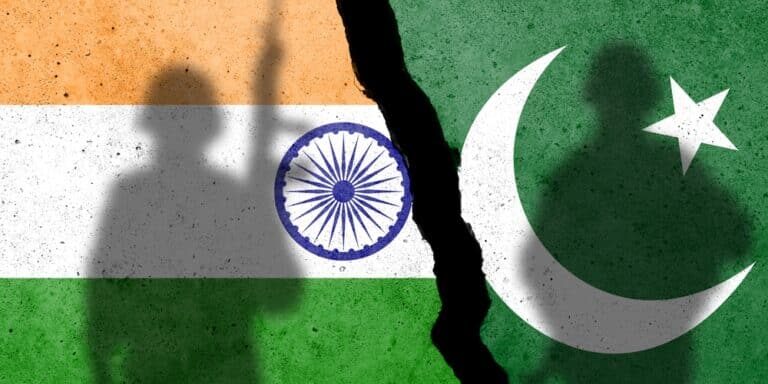
A Clash of Nuclear Titans: India and Pakistan Edge Closer to Armageddon
The Powder Keg Ignites: A Familiar Spark
The latest chapter in the Indo-Pakistani blood feud erupted on April 22 with a terrorist attack that claimed 26 lives in Pahalgam, Kashmir—mostly Indian tourists caught in the crossfire. Indian intelligence swiftly pointed the finger at Pakistan’s notorious ISI, whose fingerprints were found all over the carnage.
India’s response was swift and unrelenting—a barrage of drones, fighter jets, and missiles pummeling terrorist bases inside Pakistan. What began as a localized attack has spiraled into a regional inferno, inching both nuclear-armed states closer to the abyss.
A History Written in Blood
Few understand how deeply rooted this conflict is. India and Pakistan have been locked in a mortal dance since 1947, when British imperial arrogance carved up the subcontinent along religious lines, leaving Kashmir as the perpetual tripwire. Since then, Kashmir has been the spark for every Indo-Pakistani war: 1947-48, 1965, 1984-2003, 1999, and now this. Each chapter of bloodshed has only increased the stakes, and now, the stakes are existential.
The New Weapons of Mass Destruction
The difference this time lies in the terrifying arsenal at both sides’ disposal. High-speed missiles, AI-powered surveillance, satellite reconnaissance, and nuclear payloads are all locked and loaded, ready to turn the subcontinent into a wasteland in the blink of an eye.
Gone are the days when these conflicts were confined to the icy passes of Kashmir. Indian airstrikes have already reached deep into Pakistan, hitting Rawalpindi—alarmingly close to Islamabad’s political heart. Pakistan has returned the favor, striking Indian air bases far from the contested region. The gloves are off, and both sides are inching closer to total war.
Water Wars: The Hidden Front
While the nuclear countdown ticks away, another shadow war is unfolding—one fought with water instead of warheads.
Pakistan depends on the Indus River for over 80% of its irrigation and a third of its hydroelectric power, but that river begins in India-controlled territory. India has already suspended the water-sharing treaty, leaving Pakistan vulnerable to future water blackmail.
India isn’t invulnerable. The Brahmaputra River, vital to India’s survival, originates in Chinese-controlled lands. China, already in Pakistan’s corner, holds the keys to India’s water lifeline. If India cuts Pakistan’s water, China can return the favor. Water wars are no stranger to history, and in South Asia, they’re just another match waiting to be lit.
The Phantom Ceasefire: Peace in Name Only
On May 10, a ceasefire was announced, with the White House quick to claim credit. Within hours, however, India accused Pakistan of fresh ceasefire violations. The line of control remains as unstable as ever.
India’s nationalist regime continues to posture for “escalatory dominance,” while Pakistan’s internal turmoil and Islamist militancy keep the country teetering on the brink. Neither side seems willing to blink first. If the nukes fly, global powers may be forced to intervene—possibly even eliminating India’s and Pakistan’s nuclear arsenals to save humanity from nuclear extinction. Any such mission would bring its own horrors, but the alternative is unthinkable.
The U.S. in the Crosshairs: No Escape from Fallout
The illusion that this is just an “over there” problem is one of the most dangerous lies. A nuclear exchange between India and Pakistan wouldn’t just poison South Asia—it would poison the entire globe.
The fallout wouldn’t stay put. Radiation clouds don’t respect borders. The humanitarian catastrophe would be followed by a climate catastrophe, sending radioactive particles across the Pacific and into American skies, contaminating crops, water supplies, and lives.
The risk of direct U.S. involvement is real, too. Should the conflict spiral out of control, the U.S. might be forced to launch a preemptive strike to neutralize both countries’ nuclear arsenals—a mission that would unleash radiation leaks, global outrage, and the possibility of a war with China if it steps in to back Pakistan. The Pentagon’s so-called “game theoretic” approach to preventing Armageddon could quickly become a real-world nightmare.
The world’s financial system wouldn’t be spared either. Markets would plunge as investors flee to the so-called safe havens—Treasuries, cash, and gold—while the military-industrial complex cashes in on the chaos. Make no mistake: the consequences of this powder keg aren’t just for India and Pakistan. They’re for every American, every family, every community that’s been lulled to sleep by mainstream propaganda.
Ticking Toward the Endgame
Corporate media continues to spin illusions of peace, but behind the headlines, the drums of nuclear war beat louder. These aren’t local skirmishes—they’re a high-stakes nuclear showdown where miscalculations could end civilization as it’s known.
In a world where war is good business and water is a weapon, survival is no longer guaranteed. That’s why it’s crucial to prepare. Download “Seven Steps to Protect Yourself from Bank Failure” by Bill Brocius and start fortifying your personal defenses—because in a world this unstable, your money is the first target.
👉 Download it here now
Globalists want you distracted. Don’t be. Stay vigilant, stay informed, and protect what’s yours.











